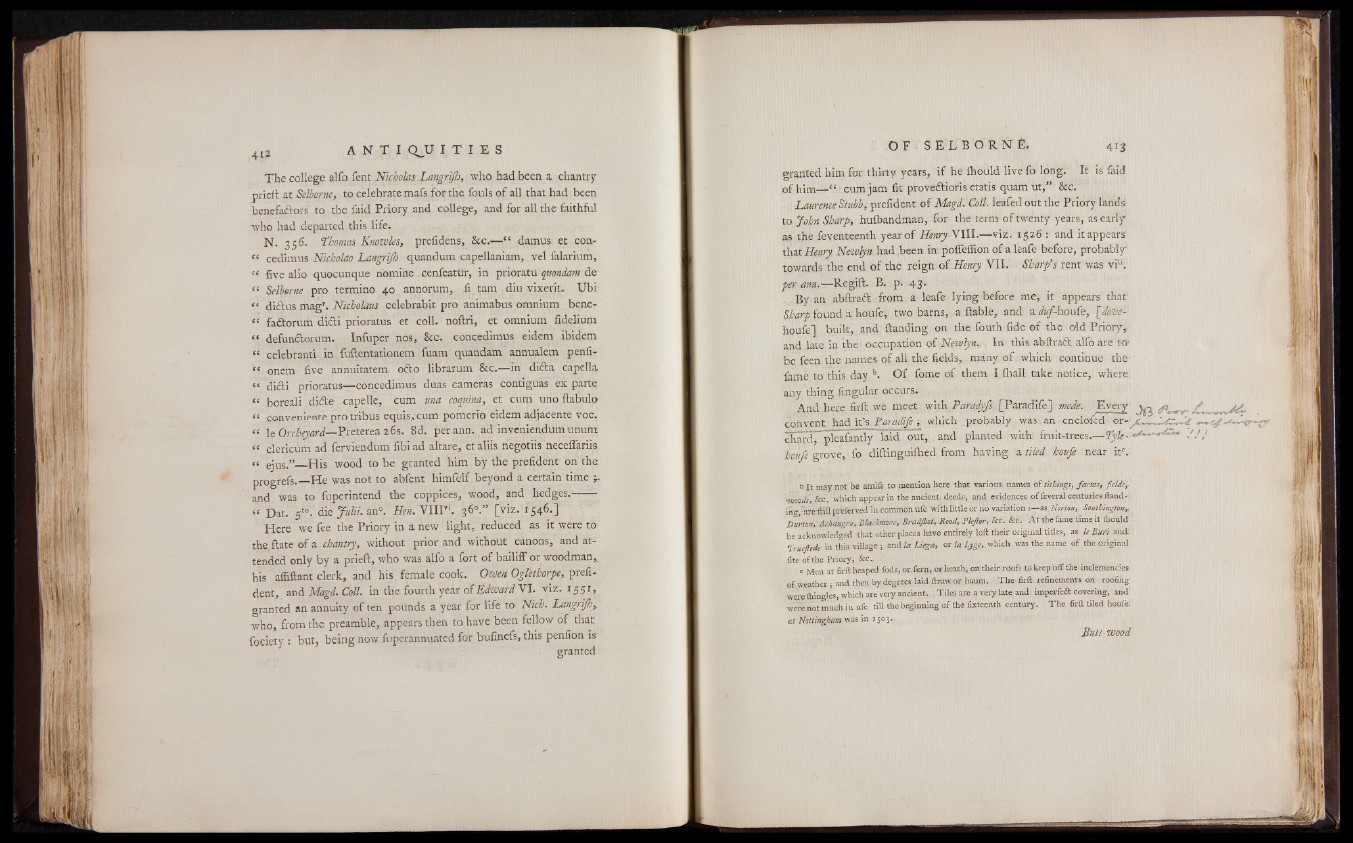
The college alfo fent Nicholas Langrijh, • who had been a chantry
prieit at Selborne, to celebrate mafs for the fouls of all that had been
benefaftors to the faid Priory and college, and for all the faithful
who had departed this life.
N. 356. Thomas Knowles, prefidens, &c.— “ damus et con-
“ cedimus Nicholao Langrijh quandum capellaniam, vel falarium,
H five alio quocunque nomine eenfeatur, in prioratu quondam de
“ Selborne pro termino 40 annorum, fi tam diu vixerit. Ubi’
“ dictus magr. Nicholaus celebrabit pro animabus omnium bene-
“ fadtorum didli prioratus et coll, noftri, et omnium fidelium
“ defunctorum. Infuper nos, &c. concedimus eidem ibidem
“ celebranti in fuftentationem fuam quandam annualem penfi-
“ onem five annuitatem odlo librarum &c.— in didta capella,
“ dicli prioratus— concedimus duas cameras contiguas ex parte
“ boreali didte capelle, cum una coquina, et cum uno ftabulo
“ conveniente pro tribus equisycum pomerio eidem adjacente voc.
“ le Orcheyard— Preterea 26s. 8d. per ann. ad inveniendumunum
“ clericum ad ferviendum fibi ad altare, et aliis negotiis neccffariis
<t ej us.”_His wood to be granted him by the prefident on the
progrefs.— He was not to abfent Iiimfelf beyond a certain time j.
and was to fuperintend the coppices, wood, and hedges.------
1 Dat. 5t0. die Julii. an°. Hen. VIIITi. 360.” [viz. 1546.]'
Here we fee the Priory in a new light, reduced as it were to
thqftateofa chantry, without prior and without canons, and attended
only by a prieft, who was alfo a fort of bailiff or woodman*
his affiftant clerk, and his female cook. Owen Oglethorpe, prefident,
and Magd. Coll, in the fourth year of Edward VI. viz. 1551,
granted an annuity of ten pounds a year for life to Nich. Langrijhy
who, from the preamble, appears then to have been fellow of that
fociety : but, being now fuperannuated for bufinefs, this penfion is
granted
OF S EL B O R NE . 413
granted him for thirty, years, if hé Ihould live fo long. It is faid
of him— “ cum jam fit proveddoris etatis quamut,” &c.
Laurence Stubb, prefident of Magd. Coll. leafed out the Priory lands'
to John Sharp, hufbandman, for the term of twenty years, as early
as the feventeenth year of Henry VIII.— viz. 1526 : and it appears:
that Henry Newlyh had .been in poffeflion of a leafe before, probably
towards the end of the reign of Henry VII. Sharp’s rent was vi'v
per, ann.— Regift. B. p. 43.
By an abftraft from a leafe lying before me, it appears that
Sharp found a houfe, two barns, a liable,, and a duf-houfe, [dove^
houfe!}. built, and Handing on the fouth fide of the old Priory,
and. late in the' occupation q{.Newlyn. In this abftradt alfo are t c
be feen the names of all the fields, many of which continue the-
lame to this day b. Of fome of them I lhall take notice, where;
any thing lingular occurs.
And here firft we meet with Pamlyjs [Paradife] mode. Every v , /f
convent, had it’s Paradife ; which probably was., ah enclofed or-yc----
chard", pieafantly laid out, and planted with fruit-trees.—
hotife grove, fo diftinguilhed from having a tiled houfe near itc,
b i t may not be amifs to mention here that various names o f tithings, farms, fields,-
woods, fee. which appear in the ancient, deeds, and evidences o f feveral centuries ftand-
ing/are-ftill preferved in common ufe with little "or ho variation as „Norton, Southington,.
Burlo*, Achangre, Blackmon, Bradjhct, Rood, Plejlor, &c.. See. A t the fame time it (hould
be acknowledged that other places have entirely loft their original titles, as U Bari and:
Brucfttde in this village ; and la Litga, or la Lyge, which was the name o f the original
fite of the Priory, &c . .
c Men at firft heaped fods, or.fern, or heath, off their roofs tokeepoff the inclemencies
of weather; and then by degrees laid ftraw or haum. T h e firft refinements on roofing
were ihingles, which are very ancient.. Tiles are a very late and impede« covering, and'
were not much in ufe till the beginning of the fixteenth centuiy. T h e firft tiled houfe
at Nottingham was in J 5° 3*r
Butt-wood